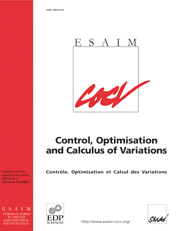Crossref Citations
This article has been cited by the following publications. This list is generated based on data provided by Crossref.
Nicaise, Serge
and
Pignotti, Cristina
2007.
Functional Analysis and Evolution Equations.
p.
515.
Nicaise, Serge
2008.
Boundary observability of a numerical approximation scheme of Maxwell’s system in a cube.
Collectanea mathematica,
Vol. 59,
Issue. 1,
p.
27.
Slodička, Marián
and
Zemanová, Viera
2008.
Time-discretization scheme for quasi-static Maxwell's equations with a non-linear boundary condition.
Journal of Computational and Applied Mathematics,
Vol. 216,
Issue. 2,
p.
514.
Suazo, Luis R.
and
Liu, Weijiu
2009.
Controlling the motion of charged particles in a vacuum electromagnetic field from the boundary.
Automatica,
Vol. 45,
Issue. 4,
p.
1012.
Slodička, Marián
and
Durand, Stephane
2011.
Fully discrete finite element scheme for Maxwell's equations with non-linear boundary condition.
Journal of Mathematical Analysis and Applications,
Vol. 375,
Issue. 1,
p.
230.
Nicaise, Serge
Pignotti, Cristina
and
Valein, Julie
2011.
Exponential stability of the wave equation with
boundary time-varying delay.
Discrete & Continuous Dynamical Systems - S,
Vol. 4,
Issue. 3,
p.
693.
Weiss, George
and
Staffans, Olof J.
2013.
Maxwell's Equations as a Scattering Passive Linear System.
SIAM Journal on Control and Optimization,
Vol. 51,
Issue. 5,
p.
3722.
Zemanová, Viera
and
Slodička, Marián
2014.
Quasi-static Maxwell's equations with a dissipative non-linear boundary condition: Full discretization.
Journal of Mathematical Analysis and Applications,
Vol. 418,
Issue. 1,
p.
31.
Anikushyn, Andrii
and
Pokojovy, Michael
2019.
Global well-posedness and exponential stability for heterogeneous anisotropic Maxwell's equations under a nonlinear boundary feedback with delay.
Journal of Mathematical Analysis and Applications,
Vol. 475,
Issue. 1,
p.
278.
Pokojovy, Michael
and
Schnaubelt, Roland
2020.
Boundary stabilization of quasilinear Maxwell equations.
Journal of Differential Equations,
Vol. 268,
Issue. 2,
p.
784.
Dörfler, Willy
Hochbruck, Marlis
Köhler, Jonas
Rieder, Andreas
Schnaubelt, Roland
and
Wieners, Christian
2023.
Wave Phenomena.
Vol. 49,
Issue. ,
p.
133.
Yao, Changhui
Sun, Rong
and
Huang, Qiumei
2023.
Global well-posedness and exponential stability for Maxwell's equations under delayed boundary condition in metamaterials.
Journal of Differential Equations,
Vol. 365,
Issue. ,
p.
168.
Nutt, Richard
and
Schnaubelt, Roland
2024.
Normal trace inequalities and decay of solutions to the nonlinear Maxwell system with absorbing boundary.
Journal of Mathematical Analysis and Applications,
Vol. 532,
Issue. 1,
p.
127915.
Shanghui, Jia
Rong, Sun
and
Changhui, Yao
2024.
Finite element methods of Maxwell's equations with nonlinear instantaneous delay boundary condition in metamaterials.
SCIENTIA SINICA Mathematica,
Skrepek, Nathanael
and
Waurick, Marcus
2024.
Semi-uniform stabilization of anisotropic Maxwell's equations via boundary feedback on split boundary.
Journal of Differential Equations,
Vol. 394,
Issue. ,
p.
345.

